转载于:https://blog.csdn.net/aitangyong/article/details/53889036
guava-retrying提供了WaitStrategy接口,用来控制2次重试的时间间隔,这个接口与StopStrategy有的类似。内置的等待策略在WaitStrategies中定义。
-
import java.io.IOException;
-
import java.text.SimpleDateFormat;
-
import java.util.Date;
-
import java.util.concurrent.Callable;
-
-
public
class
AlwaysExceptionTask
implements
Callable<Boolean> {
-
-
private
static
final
SimpleDateFormat
df
=
new
SimpleDateFormat(
"yyyy-MM-dd hh:mm:ss,SSS");
-
private
int
times
=
1;
-
-
@Override
-
public Boolean
call
()
throws Exception {
-
System.out.println(df.format(
new
Date()));
-
int
thisTimes
= times;
-
times++;
-
-
if (thisTimes ==
1) {
-
throw
new
NullPointerException();
-
}
else
if (thisTimes ==
2) {
-
throw
new
IOException();
-
}
else
if (thisTimes ==
3) {
-
throw
new
ArithmeticException();
-
}
else {
-
throw
new
Exception();
-
}
-
}
-
}
WaitStrategies.noWait()失败后立刻重试,没有等待时间。
-
Retryer<Boolean> retryer = RetryerBuilder.<Boolean>newBuilder()
-
.retryIfException()
-
.withWaitStrategy(WaitStrategies.noWait())
-
.build();
-
-
System.out.println(
"begin..." + df.format(
new
Date()));
-
-
try {
-
retryer.call(
new
AlwaysExceptionTask());
-
}
catch (Exception e) {
-
System.err.println(
"still failed after retry." + e.getCause().toString());
-
}
-
-
System.out.println(
"end..." + df.format(
new
Date()));
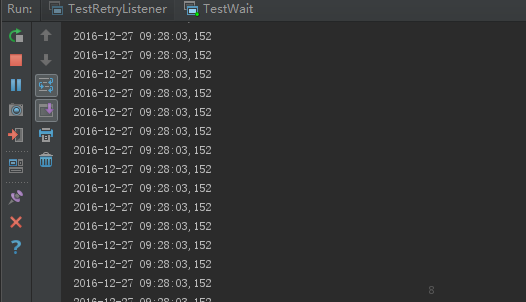
WaitStrategies.fixedWait(1, TimeUnit.SECONDS)间隔固定时间之后重试,比如每隔1s重试一次。
-
Retryer<Boolean> retryer = RetryerBuilder.<Boolean>newBuilder()
-
.retryIfException()
-
.withWaitStrategy(WaitStrategies.fixedWait(
1, TimeUnit.SECONDS))
-
.build();
-
-
System.out.println(
"begin..." + df.format(
new
Date()));
-
-
try {
-
retryer.call(
new
AlwaysExceptionTask());
-
}
catch (Exception e) {
-
System.err.println(
"still failed after retry." + e.getCause().toString());
-
}
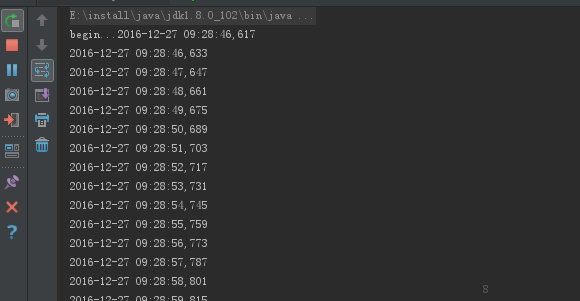
WaitStrategies.randomWait(3, TimeUnit.SECONDS)间隔随机时间后重试,比如间隔0~3中随机时间后重试。
-
Retryer<Boolean> retryer = RetryerBuilder.<Boolean>newBuilder()
-
.retryIfException()
-
.withWaitStrategy(WaitStrategies.randomWait(
3, TimeUnit.SECONDS))
-
.build();
-
-
System.out.println(
"begin..." + df.format(
new
Date()));
-
-
try {
-
retryer.call(
new
AlwaysExceptionTask());
-
}
catch (Exception e) {
-
System.err.println(
"still failed after retry." + e.getCause().toString());
-
}
-
-
System.out.println(
"end..." + df.format(
new
Date()));
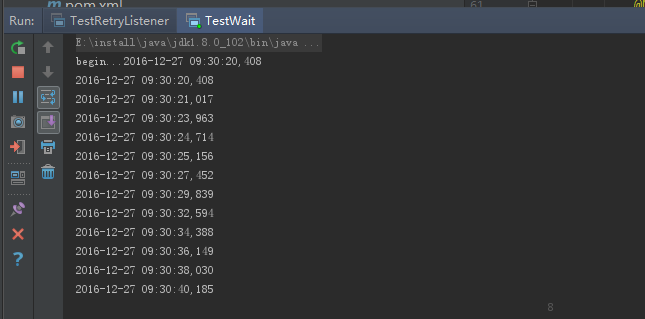
WaitStrategies.randomWait(2, TimeUnit.SECONDS, 5, TimeUnit.SECONDS)最小值,最大值之间的随机时间。
-
Retryer<Boolean> retryer = RetryerBuilder.<Boolean>newBuilder()
-
.retryIfException()
-
.withWaitStrategy(WaitStrategies.randomWait(
2, TimeUnit.SECONDS,
5, TimeUnit.SECONDS))
-
.build();
-
-
System.out.println(
"begin..." + df.format(
new
Date()));
-
-
try {
-
retryer.call(
new
AlwaysExceptionTask());
-
}
catch (Exception e) {
-
System.err.println(
"still failed after retry." + e.getCause().toString());
-
}
-
-
System.out.println(
"end..." + df.format(
new
Date()));
WaitStrategies.incrementingWait增量重试,重试的次数越多,等待时间间隔越长。incrementingWait需要传递2个参数,一个是initialSleepTime(第一次到第二次尝试的间隔),一个是increment(每增加一次尝试,需要增加的时间间隔)。第一次尝试是不需要等待的,因为guava-retrying中的第一次尝试,对应正常的第一次调用。从第二次重试开始,第n-1次到n次间隔是:initialSleepTime + (n-2)*increment。
1、WaitStrategies.incrementingWait(0, TimeUnit.SECONDS, 0, TimeUnit.SECONDS)等价于 WaitStrategies.noWait()。
2、 WaitStrategies.incrementingWait(1, TimeUnit.SECONDS, 0, TimeUnit.SECONDS)等价于WaitStrategies.fixedWait(1, TimeUnit.SECONDS)
3、 WaitStrategies.incrementingWait(0, TimeUnit.SECONDS, 1, TimeUnit.SECONDS)等价于WaitStrategies.fixedWait(1, TimeUnit.SECONDS)。
4、 WaitStrategies.incrementingWait(1, TimeUnit.SECONDS, 1, TimeUnit.SECONDS)
WaitStrategies.fibonacciWait()按照斐波那契数列等待。fibonacciWait(long multiplier,long maximumTime,TimeUnit maximumTimeUnit),multiplier单位固定是ms,maximumTime最大等待时间。n=1的时候,是无需等待的。当n>=2的时候,开始符合斐波那契数列。n=2的时候,等待1 * multiplier毫秒;n=3的时候,等待1 * multiplier毫秒;n=4的时候,等待2 * multiplier毫秒;n=5的时候,等待3 * multiplier毫秒;n=6的时候,等待5 * multiplier毫秒;n=7的时候,等待8 * multiplier毫秒;n=8的时候,等待15 * multiplier毫秒;......但是等待时间最长不超过maximumTime。
-
Retryer<Boolean> retryer = RetryerBuilder.<Boolean>newBuilder()
-
.retryIfException()
-
.withWaitStrategy(WaitStrategies.fibonacciWait(
100,
10, TimeUnit.SECONDS))
-
.build();
-
-
System.out.println(
"begin..." + df.format(
new
Date()));
-
-
try {
-
retryer.call(
new
AlwaysExceptionTask());
-
}
catch (Exception e) {
-
System.err.println(
"still failed after retry." + e.getCause().toString());
-
}

WaitStrategies.exponentialWait按照指数递增(2的n次方)来等待,各个参数含义与fibonacciWait相同。
-
Retryer<Boolean> retryer = RetryerBuilder.<Boolean>newBuilder()
-
.retryIfException()
-
.withWaitStrategy(WaitStrategies.exponentialWait(
100,
10, TimeUnit.SECONDS))
-
.build();
-
-
System.out.println(
"begin..." + df.format(
new
Date()));
-
-
try {
-
retryer.call(
new
AlwaysExceptionTask());
-
}
catch (Exception e) {
-
System.err.println(
"still failed after retry." + e.getCause().toString());
-
}

WaitStrategies.exceptionWait根据抛出的异常来决定等待的时间长短,没有什么实际用处,不过作为学习还是可以了解下,说不定将来能排上用场呢。下面我们定义1个任务,随机抛出不同异常。
-
class
RandomExceptionTask
implements
Callable<Boolean> {
-
@Override
-
public Boolean
call
()
throws Exception {
-
int
round
= (
int) Math.floor(Math.random() *
8);
-
System.out.println(
"round=" + round +
",time=" + df.format(
new
Date()));
-
if (round ==
1) {
-
throw
new
NullPointerException();
-
}
else
if (round ==
2) {
-
throw
new
IOException();
-
}
else
if (round ==
3) {
-
throw
new
ArithmeticException();
-
}
else
if (round ==
4) {
-
throw
new
IllegalStateException();
-
}
else
if (round ==
5) {
-
throw
new
IndexOutOfBoundsException();
-
}
else {
-
return
true;
-
}
-
}
-
}
-
// 根据不同异常,等待不同时间后重试
-
private
static <T
extends
Throwable> Function<T, Long>
itsFunction
(Class<T> exceptionClass) {
-
Function<T, Long> result =
new
Function<T, Long>() {
-
@Nullable
-
@Override
-
public Long
apply
(@Nullable T input) {
-
if (input
instanceof NullPointerException) {
-
return
1 *
1000L;
-
}
else
if (input
instanceof IOException) {
-
return
2 *
1000L;
-
}
else
if (input
instanceof ArithmeticException) {
-
return
3 *
1000L;
-
}
else
if (input
instanceof IllegalStateException) {
-
return
4 *
1000L;
-
}
else
if (input
instanceof IndexOutOfBoundsException) {
-
return
5 *
1000L;
-
}
else {
-
return
0L;
-
}
-
}
-
};
-
return result;
-
}
下面是测试代码,可以看出不同的异常确实会导致不同的重试间隔。
-
WaitStrategy
exceptionJoin
= WaitStrategies.join(
-
WaitStrategies.exceptionWait(NullPointerException.class, itsFunction(NullPointerException.class)),
-
WaitStrategies.exceptionWait(IOException.class, itsFunction(IOException.class)),
-
WaitStrategies.exceptionWait(ArithmeticException.class, itsFunction(ArithmeticException.class)),
-
WaitStrategies.exceptionWait(IllegalStateException.class, itsFunction(IllegalStateException.class)),
-
WaitStrategies.exceptionWait(IndexOutOfBoundsException.class, itsFunction(IndexOutOfBoundsException.class))
-
);
-
-
Retryer<Boolean> retryer = RetryerBuilder.<Boolean>newBuilder()
-
.retryIfException()
-
.withWaitStrategy(exceptionJoin)
-
.build();
-
-
System.out.println(
"begin..." + df.format(
new
Date()));
-
-
try {
-
retryer.call(
new
RandomExceptionTask());
-
}
catch (Exception e) {
-
System.err.println(
"still failed after retry." + e.getCause().toString());
-
}
-
-
System.out.println(
"end..." + df.format(
new
Date()));











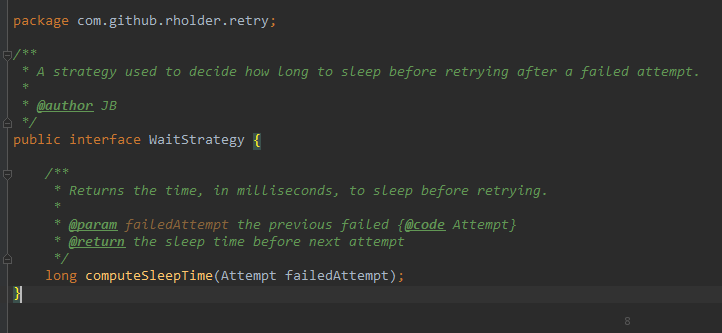
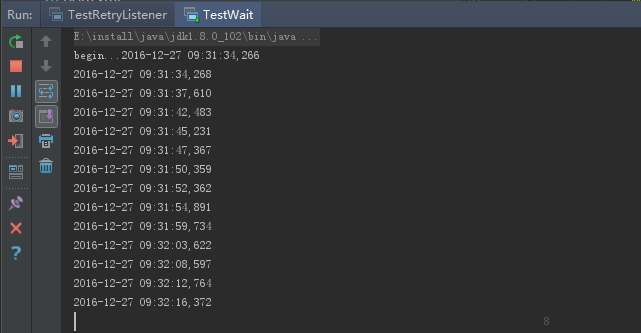
















 5287
5287











 被折叠的 条评论
为什么被折叠?
被折叠的 条评论
为什么被折叠?








